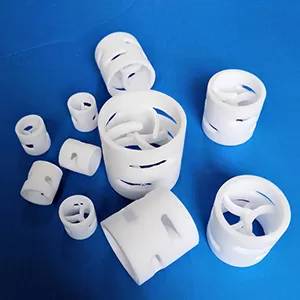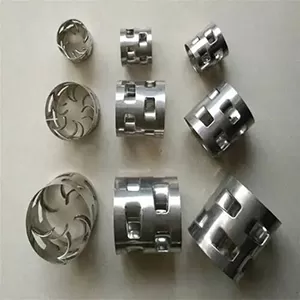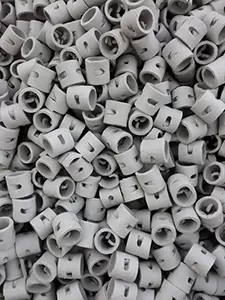The weight of one cubic meter of pall ring packing
Due to the differences in material and specifications, the weight of pall ring packing per cubic meter varies significantly. The specific data is as follows:

Plastic pall ring
The density of plastic pall ring is relatively low, and its weight is relatively light. Taking the common specifications as an example:
φ25 specification: Its bulk weight is approximately 85 kg/m³, and it is often used in small-scale exhaust gas absorption towers and other equipment. The relatively light weight can reduce the load-bearing pressure of the equipment.
φ38 specification: The bulk weight is approximately 82 kg/m³, and it is suitable for medium-sized scale mass transfer equipment. While ensuring a certain processing capacity, it will not impose excessive burden on the equipment.
φ50 specification: The bulk weight is approximately 60 kg/m³, and when used in large towers, its relatively light weight can reduce the construction cost of the equipment foundation.
φ76 specification: The bulk weight is approximately 62 kg/m³, and when used in large towers, it can reduce the equipment foundation construction cost by leveraging its lighter weight advantage.
Metal pall ring

The metal material determines that the metal pall ring is relatively heavy:
φ25 specification: The bulk weight reaches 393 kg/m³, and it is often used in scenarios requiring high mass transfer efficiency and strong equipment load-bearing capacity, such as some distillation towers in fine chemical processes.
φ38 specification: The bulk weight is approximately 318 kg/m³, and it is commonly seen in some towers in petroleum refining. It balances mass transfer performance with equipment load-bearing capacity.
φ50 specification: The bulk weight is approximately 314 kg/m³, and when used in large chemical equipment absorption towers, it can maintain the gas-liquid contact effect while adapting to the equipment load-bearing conditions.
φ76 specification: The bulk weight is approximately 308 kg/m³, and it is suitable for large gas separation devices. The large-sized and heavy packing can operate stably at high gas velocities and ensure the mass transfer effect.
Ceramic pall ring

Ceramic pall ring has the characteristics of high temperature resistance and corrosion resistance, and its weight is relatively large:
φ25 specification: The bulk weight is approximately 630 kg/m³, and it is often used in towers in high-temperature and highly corrosive environments, such as exhaust gas treatment towers in high-temperature kilns. Its heavier weight can make the packing layer more stable.
φ38 specification: The bulk weight is approximately 590 kg/m³, and it is commonly seen in absorption towers in chemical production involving corrosive media, with its own weight advantage effectively preventing the shaking and shifting of the packing layer.
φ50 specification: The bulk weight is approximately 520 kg/m³, and it is applied in absorption towers in large sulfuric acid production devices, with the heavy weight helping to maintain the stability of the packing layer and ensuring the gas-liquid mass transfer efficiency.
φ76 specification: The bulk weight is approximately 470 kg/m³, and it is suitable for large high-temperature and highly corrosive industrial devices. The large-sized and heavy ceramic pall ring can operate stably in extreme conditions and achieve efficient mass transfer and heat transfer.

